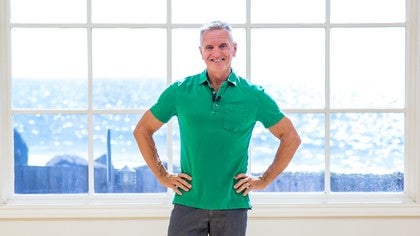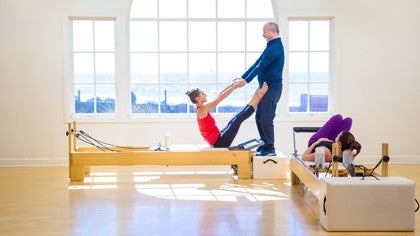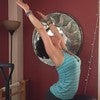Description
About This Video
Transcript
Read Full Transcript
Hi, I'm Troy McCarty. I've been teaching now for about over probably 34, 35 years, and I have my studios in Cleveland, Ohio. I'm gonna talk to you today about filming. So it's been a real honor to come out here to Pilates Anytime and to show my skills out to the world, but one of the things I did before I came to Pilates Anytime was I called a newscaster that was coming to my studio and I asked her, I'm gonna be filming. Could you work with me, and she said absolutely.
So she would bring me down to the news studio and with cameras similar to what we're working with right now, she'd have me go through exercises and one of the things that she taught me was how to look into the camera, and that can be intimidating because the camera's not really emoting any type of feeling to you but she taught me if I would bring a picture, so what I did is I brought a picture of my dog and they put the picture on the camera so any time I looked into the camera I saw the picture of my dog and my eyes were emoting this feeling, this nurturing feeling, instead of just a cold camera lens. Another thing that she taught me too, was when you look into the lens, try to visualize your image in the lens and that really helped me. She also taught me to slow down when I talk, I was all about bobbing my head and using my hands a lot, she really calmed me down, and she really structured me. She said it's almost like you wanna bring the people into your studio. So when I was talking and giving the exercises, it was like I was almost inviting them in.
So just to kind of talk about that again, get a picture, child, dog, boyfriend, girlfriend, husband, put it on the camera, and every time you look into the camera, see that picture. And another thing that's gonna help is that idea that you're looking into the lens and you're trying to see your image. So working with this newscaster really helped me a lot because it helped me with commanding space. So I kind of took some of these ideas and I brought it into my studio in Cleveland, Ohio. So like when my clients come in, I want to be in charge of the space and I want them to have a very, very structured movement with me.
So I talk about okay, today's class is gonna be about this, it's a class where they're gonna come in, they're gonna have no screens in front of them, it's 50, 55 minutes of just you and them. I kind of set the tones of my class. I talk about how I want them to feel, the relaxation, and whatnot, so I'm kind of demanding, I kind of set the environment for them. It's like I want to give them nourishing movement so that they can feel this and they can move out their day and feel all this movement with them. So when I'm teaching in my group classes, I use my voice a lot.
Sometimes I'll punch my words, sometimes I get really soft, sometimes I give them silence. I think the silence is a nice additive to it because it gives that client a chance to think. I mean we all want to throw our cues, we want to talk, talk fill the environment with our voice, but I think if you slow down and maybe just have that moment of silence, I think your clients can better retain what you're telling them to do. Also when I'm working with my clients, I really try to think about my space and their space. It's like where do I stand when I'm working with a client?
Let's say the client is doing their footwork. I don't wanna stand right in front of their feet 'cause that's not, they don't feel real, real comfortable with that. So what I try to do is I try to move my body and one of the things I learned from working with basketball players in Cleveland, was I don't want to tower over them because they felt really intimidated. So I'd bring myself down to their level. So that way I'm kind of more in line with that client and wasn't so intimidating and having this towering presence over them.
The other thing I do too is I move around my client. My voice may be next to the client, I may get up and step out, my voice may be over there, my voice may be over there, so the client gets a chance to really register what's going on. I'm always global so I'm always walking around, walking in, and walking out. One of the things that I really like to do with my clients is we do this five breath awareness. So let's say the client is doing something really incredible and I want them to remember that.
So what I do is I go okay, let's take a moment, let's take an inhale and during your exhale, I want you to feel what it's like to be sitting there nice and tall. So I'll take an exhale and we'll talk about the shoulders coming down. We'll take another inhale, exhale, I'll talk about them sitting nice and tall on their sit bones, another inhale exhale we'll talk about the spine. I feel with these five breaths I can really get my clients to remember this, to really feel it instead of just saying oh boy, your posture's really good, now let's move on. So I do take that time and I try to bring awareness.
The other thing too, with all the years I've been teaching is when my clients come in, I kind of look at them like an empty canvas. With my client and myself, I take that canvas, and we're gonna paint this beautiful picture together. You know, Pilates is about you and your client. It's about your knowledge, and giving it to your client. We live in a very, very busy world and giving clients this structured movement, this chance to paint this beautiful picture together, that's what I feel Pilates is.
Thanks for watching me, enjoy.
The Teacher's Corner: Teaching Tools
Comments
You need to be a subscriber to post a comment.
Please Log In or Create an Account to start your free trial.



















